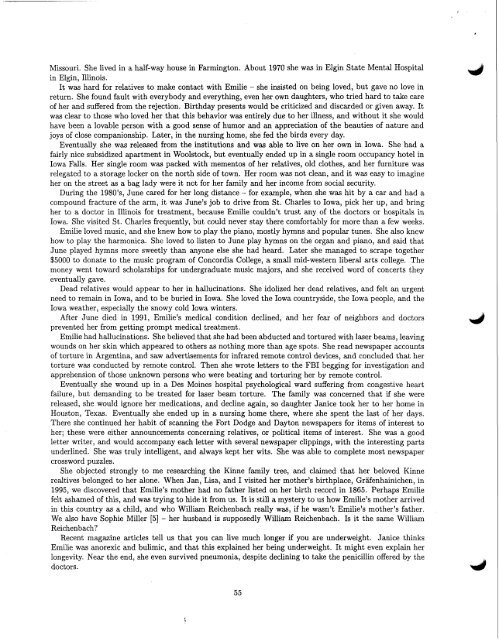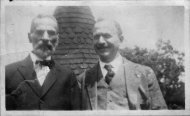2409 S. Vine Urbana, Illinois 61801 - Richard R. Grayson, MD
2409 S. Vine Urbana, Illinois 61801 - Richard R. Grayson, MD
2409 S. Vine Urbana, Illinois 61801 - Richard R. Grayson, MD
Create successful ePaper yourself
Turn your PDF publications into a flip-book with our unique Google optimized e-Paper software.
Missouri. She lived in a half-way house in Farmington. About 1970 she was in Elgin State Mental Hospital<br />
in Elgin, <strong>Illinois</strong>.<br />
It was hard for relatives to make contact with Emilie - she insisted on being loved, but gave no love in<br />
return. She found fault with everybody and everything, even her own daughters, who tried hard to take care<br />
of her and suffered from the rejection. Birthday presents would be criticized and discarded or given away. It<br />
was clear to those who loved her that this behavior was entirely due to her illness, and without it she would<br />
have been a lovable person with a good sense of humor and an appreciation of the beauties of nature and<br />
joys of close companionship. Later, in the nursing home, she fed the birds every day.<br />
Eventually she was released from the institutions and was able to live on her own in Iowa. She had a<br />
fairly nice subsidized apartment in Woolstock, but eventually ended up in a single room occupancy hotel in<br />
Iowa Falls. Her single room was packed with mementos of her relatives, old clothes, and her furniture was<br />
relegated to a storage locker on the north side of town. Her room was not clean, and it was easy to imagine<br />
her on the street as a bag lady were it not for her family and her income from social security.<br />
During the 19807s, June cared for her long distance - for example, when she was hit by a car and had a<br />
compound fracture of the arm, it was June's job to drive from St. Charles to Iowa, pick her up, and bring<br />
her to a doctor in <strong>Illinois</strong> for treatment, because Emilie couldn't trust any of the doctors or hospitals in<br />
Iowa. She visited St. Charles frequently, but could never stay there comfortably for more than a few weeks.<br />
Emilie loved music, and she knew how to play the piano, mostly hymns and popular tunes. She also knew<br />
how to play the harmonica. She loved to listen to June play hymns on the organ and piano, and said that<br />
June played hymns more sweetly than anyone else she had heard. Later she managed to scrape together<br />
$5000 to donate to the music program of Concordia College, a small mid-western liberal arts college. The<br />
money went toward scholarships for undergraduate music majors, and she received word of concerts they<br />
eventually gave.<br />
Dead relatives would appear to her in hallucinations. She idolized her dead relatives, and felt an urgent<br />
need to remain in Iowa, and to be buried in Iowa. She loved the Iowa countryside, the Iowa people, and the<br />
Iowa weather, especially the snowy cold Iowa winters.<br />
After June died in 1991, Emilie's medical condition declined, and her fear of neighbors and doctors<br />
prevented her from getting prompt medical treatment.<br />
Emilie had hallucinations. She believed that she had been abducted and tortured with laser beams, leaving<br />
wounds on her skin which appeared to others as nothing more than age spots. She read newspaper accounts<br />
of torture in Argentina, and saw advertisements for infrared remote control devices, and concluded that her<br />
torture was conducted by remote control. Then she wrote letters to the FBI begging for investigation and<br />
apprehension of those unknown persons who were beating and torturing her by remote control.<br />
Eventually she wound up in a Des Moines hospital psychological ward suffering from congestive heart<br />
failure, but demanding to be treated for laser beam torture. The family was concerned that if she were<br />
released, she would ignore her medications, and decline again, so daughter Janice took her to her home in<br />
Houston, Texas. Eventually she ended up in a nursing home there, where she spent the last of her days.<br />
There she continued her habit of scanning the Fort Dodge and Dayton newspapers for items of interest to<br />
her; these were either announcements concerning relatives, or political items of interest. She was a good<br />
letter writer, and would accompany each letter with several newspaper clippings, with the interesting parts<br />
underlined. She was truly intelligent, and always kept her wits. She was able to complete most newspaper<br />
crossword puzzles.<br />
She objected strongly to me researching the Kinne family tree, and claimed that her beloved Kinne<br />
realtives belonged to her alone. When Jan, Lisa, and I visited her mother's birthplace, Grafenhainichen, in<br />
1995, we discovered that Emilie's mother had no father listed on her birth record in 1865. Perhaps Emilie<br />
felt ashamed of this, and was trying to hide it from us. It is still a mystery to us how Emilie's mother arrived<br />
in this country as a child, and who William Reichenbach really was, if he wasn't Emilie's mother's father.<br />
We also have Sophie Miller [5] - her husband is supposedly William Reichenbach. Is it the same William<br />
Reichenbach?<br />
Recent magazine articles tell us that you can live much longer if you are underweight. Janice thinks<br />
Emilie was anorexic and bulimic, and that this explained her being underweight. It might even explain her<br />
longevity. Near the end, she even survived pneumonia, despite declining to take the penicillin offered by the<br />
doctors.



